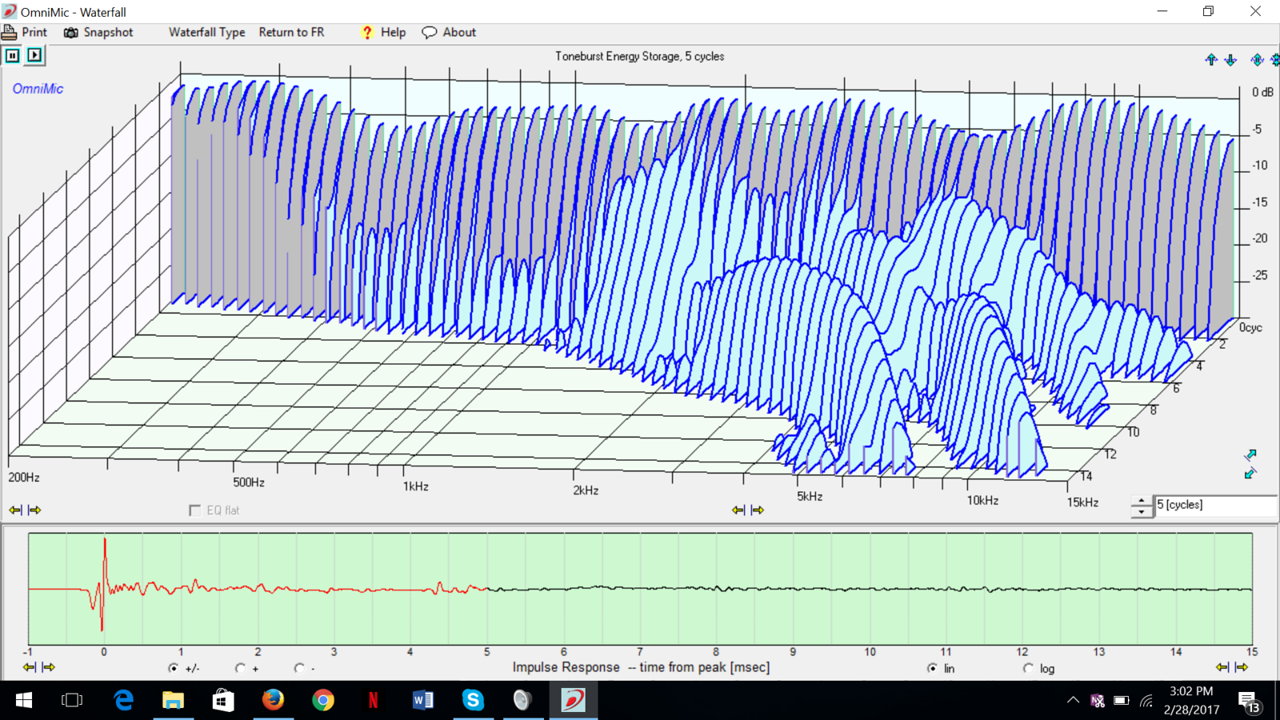Welcome Art Vandelay. You did a nice job on the 802 D2.
I now have the impedance curve and Waterfall for the 800 D3.
This is the impedance plot of the 800 D.
Not a very happy sight!
This is the impedance curve and phase angles of the 800 D3
Gone are the nasty negative phase angles and the impedance does not drop below four ohms.
This is the waterfall plot.
I have had a chance to do more extended listening. I always found the 800 Ds much too forward.
I played a disc from Hereford Cathedral. The rendition of Samuel S Wesley's Blessed be God and Father was impressive. This is one of my favorite anthems and come to that high towards the top end of my favorite compositions. The sound stage was thrown was beyond the room. The organ was distant to the choir. The two boys in the passage in descant was perfectly caught.
The sudden full organ after a "pregnant pause" really tales you by surprise the way it should and was reproduced with authority. This leads into a wonderful fugal finale for organ and chorus. The sound stage was very realistic. The 800 Ds always made a bit of a mess of that one. They were far too forward.
I also listened to a CD from the opening night of the 2016 Proms, captured from the BBC UK stream via VPN. This was Prokofiev's score for his friend Sergey Eisenstein’s patriotic film Alexander Nevsky: the cantata he fashioned from it features the dramatic
Battle on the Ice.
I don't recall I have ever heard it before. It is the sort of thing that only comes along at the Proms. There was a hugely augmented BBC Symphony orchestra, with the BBC Symphony Chorus, BBC Chorus of Wales and soloists. All conducted by Sakari Oromo, who kept the pedal firmly to the metal turning in a first night to remember. I saw it with video first in iPlayer. It was quite a spectacle.
My friend Phil just loves this CD I made for him. It will give any system a monstrous work out.
The 800 D3s turn is a spectacular rendition, however I did feel at times the single mid range driver was just exhibiting early distress. This is not the sort of program to throw at a couple of bookshelves and a sub or two!
I have to say these speakers do sound very similar to my own. I don't hear distress with mine at all and the bass is fractionally more realistic I think. Since they are different rooms that is very hard to judge.
Axis and impulse 1 meter on tweeter axis.
The HF droop is due to omni mic.
Axis and off axis response. Blue axis. Black 90 degrees off axis.
Waterfall
Distortion is right around 1% at 90 db 1 meter only rising to a hair over 2% at the limits of the LF response.
Center speaker.
The axis is the blue line, which interestingly is the poorest response, probably due to cone reflections. The dip in response of these SEAS coax units centered on 9 KHz, was corrected by employing a correction network to tweeter in the upper unit, which is the BSC driver.
Waterfall.
The front three where built in 2006.
The surrounds and rear backs.
Surround FR
Axis is blue. I do not know why there is a dip at 1.5 KHz in the axis response. It is likely location.
Waterfall
Built 1984. Box and crossover designed with the help of Bullock and White's software on floppy discs using an Apple IIe. These are the first of my speakers designed with computer assistance. Final tuning by ear. I have not touched them in years. You can see by the impulse response I did not brace the box adequately. These are sealed units, and the bass ripple is a couple of db higher than calculated. They do sound a little on the warm side.
Rear back FR
I can't get off axis response due to location.
Waterfall.

These speakers were started in 1979, but did not reach final form until around 1990. It is a four way. There is an active third order crossover at 200 Hz, and a first order series crossover at 900 Hz, and a first order parallel crossover at 5 KHz. The drivers are time aligned. As you might imagine, this speaker was an absolute headache to get right. I had a lot of help from the good folk at Dynaudio. It shares a lot of design features with the Dynaudio Conquest. That speaker has the tweeter nearly on the ground because of the lobing problem and the orchestra sounds as if it is coming from below. I made the tweeter high, and this gives the effect of being in the orchestra level with the performers up onstage. Of course it has all the issues you might expect with sweet spots. However these speakers deliver a very lively and exciting sound. Baroque trumpets are really brilliant. They now make good rear backs for antiphonal SACDs. Now and again they still get a chance to shine. Although a headache, they did make me believe there is merit in time and phase alignment. However it leaves you with a lot of tricky problems to solve.
I must confess to hooking them up as a stereo pair periodically and give them a good listen. They are an exciting speaker but not over the top or sibilant.
This system has given and continues to give enormous pleasure.
I would say those 800 D3s will also deliver a lot of pleasure to fortunate owners.